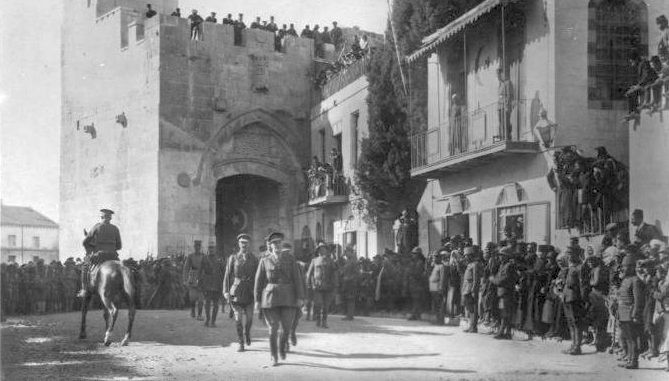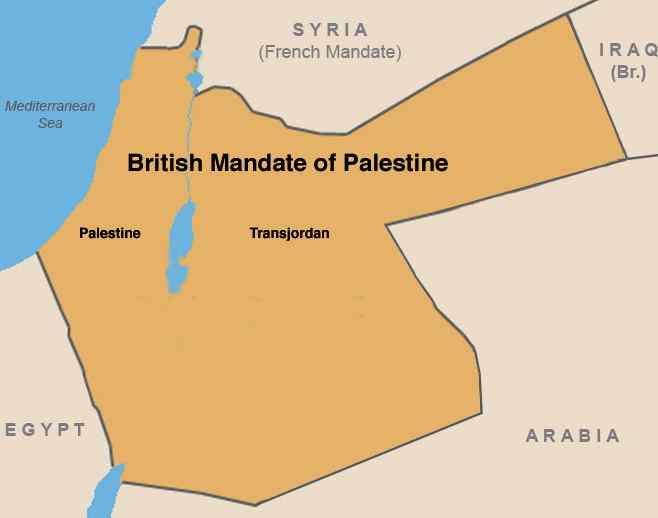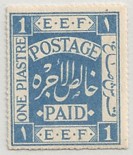ALBUM – View my British Occupation of Palestine album
TRANSITION CHART for Jordan / Palestine Area
Fast Facts
Region: Middle East
Group: Palestine/Jordan Area
Classification: Military Occupation
Prior Regime: Ottoman Empire
Key Dates:
1916, Jun 5 – Great Arab revolt against the Ottomans
1917, Dec 9 – British Forces Occupy Jerusalem
1918, Sep 26 – British Forces Occupy all of Palestine
1920, May 12 – British Mandate of Palestine established
Following Regime: British Mandate of Palestine
Scott Catalogue: # 1-14
Pick Catalogue: none
History

In more modern times, the region fell under the rule of the Ottoman Turks when they defeated the Mamluk Sultans of Egypt in 1517. Egypt had ruled Palestine since the end of the Crusades. Ottoman rule in the entire Middle East continued until World War 1. During the early part of the war, most of the action was in Persia and Iraq, however with the support of T.E. Lawrence (Lawrence of Arabia), the British negotiated support of the Grand Sherif of Mecca, Sayyid Hussein bin Ali. This led to The Great Arab Revolt in 1916, resulting in the Arab population rising up against their Ottoman masters. At the beginning of the revolt, Hussein declared the creation of the independent Kingdom of Hejez.
With British successes in the east, including the capture of Baghdad in March of 1917, they turned their attention to Arabia and the Middle East. In Sept 1917, the British led Egyptian Expeditionary Force (EEF) under the command of General Edmund Allenby began moving north from Egypt into the Sinai. Coordinating with the Arabs through T.E. Lawrence, the British were able to move swiftly and on 9 December, British forces were marching into Jerusalem. Allenby ordered his troops to dismount as they entered the city as a symbol of respect.
By 26 Sep 1917, the British EEF forces were in control of all of Palestine and the Transjordan. As WW1 began winding down, the losses for the Ottoman Empire were huge. On 30 October 1918, The Armistice of Mudros was signed on the island of Lemnos between the defeated Ottoman Empire and the Triple Entente, and within a two weeks, the French and British were occupying Constantinople. The region was governed by the Occupied Enemy Territory Administration (OETA) south until the formation of the Mandates established by the League of Nations.
With the collapse of the Ottoman Empire at the end of World War 1, the territories of the Middle East were placed under a League of Nations Mandate to France and Great Britain. A “mandate”, was a legal right of a nation to administer a territory captured during WW1 in behalf of the League of Nations. In 12 May, 1920, the region of Palestine (which included Transjordan) was placed under Mandate to the British, while the region to the north, Syria/Lebanon was placed under French mandate (which was divided into six sub-regions: Damascus, Aleppo, Alawites, Jubal Druze, the Sanjak of Alexandretta and Greater Lebanon).
A major complicating factor in the entire region was that there were multiple competing visions for the land of Palestine. In 1916, prior to beginning operations in the Middle East, there was a secret agreement between the British and French, called the Sykes-Picot Agreement, which divided up the Ottoman territories in Arabia and Mesopotamia after the conclusion of the war. In this pact, it was agreed that most of Palestine would become an international zone, not under direct control of either the French or the British. Shortly afterwards in 1917, British foreign minister Arthur Balfour issued what is know as the Balfour Declaration, which promised a “Jewish national home” in Palestine. This declaration eventually became part of the Sèvres peace treaty with the Ottoman Empire. Both of these declarations conflicted with the secret negotiations between Sayyid Hussein bin Ali and Sir Henry McMahon, the British high commissioner in Egypt to secure Arab support against the Ottomans. These negotiations are recorded in the correspondence between the two leaders, but never actually ended in an agreement.
While the mandates were implemented in 1920, the final document for the Mandate of Palestine was finalized on 12 August, 1922, and in the preamble of the document it states: “Whereas the Principal Allied Powers have also agreed that the Mandatory should be responsible for putting into effect the declaration originally made on November 2nd, 1917, by the Government of His Britannic Majesty, and adopted by the said Powers, in favor of the establishment in Palestine of a national home for the Jewish people, it being clearly understood that nothing should be done which might prejudice the civil and religious rights of existing non-Jewish communities in Palestine, or the rights and political status enjoyed by Jews in any other country.”
This did not include the region of Transjordan, therefore Palestine and Transjordan were incorporated under different legal and administrative arrangements in the “Mandate for Palestine and Transjordan Memorandum” issued by the League of Nations on 29 Sept 1923.
special note: At DCStamps, I try to use the name of a country or region as it was used during that time in history. DCStamps is not attempting to make a political statement, but be historically accurate. As the region was called Palestine by the world of nations at the time of WWI, therefore that is the name I use for this entry.
Stamps
During the occupation, the Allied Field Post Offices of the Egyptian and Indian Expeditionary Forces (EEF and IEF) handled postage duties. Initially basic postal services in all occupied territories were provided free to the local population by Army Postal services. As the occupation was stabilized, postal stamps were printed and the free postage period ended. In Palestine, the first stamps were printed by the British and issued on 10 Feb, 1918.
10 Feb 1918 “blues” – On 10 Feb, 1918, free postal service in Palestine ended for international mail with the issuance of a 1 piastre stamp. Catalogues two stamps with different shades of blue (deep blue and ultra). The simple design includes the inscription “EEF” for Egyptian Expeditionary Forces and the term “Postage Paid” in English and Arabic.
15 Feb 1918 surcharge – On 15 Feb, 1918, the British surcharged the ultra shade, 1 piastre stamp with 5 millièmes. This was issued for local postage. With the issuance of this stamp, all free postage ended in the Palestine occupied territory.
1918 Definitive set – As the first two stamps were considered “provisional”, a full set of 11 definitive stamps (1m – 20p) with the same design were issued in July, 1918. The stamps were valid in the entire occupied territories including the Sinai, Transjordan, Syria, Lebanon and Cilicia.
In 1920, with the establishment of the British Mandate, the EEF stamps were overprinted “Palestine” in Arabic, English and Hebrew.
Banknotes
Ottoman currency was used in Palestine until 1918 and Egyptian Currency was used until Great Britain issued banknotes for the Palestine mandate in 1927.
Links
Britain and France conclude Sykes-Picot agreement from the History Channel
BBC History – The Middle East during World War One
The Arab Revolt, 1916-18
Sinai and Palestine Campaign from Wikipediaz`
A Short Introduction To The Philately Of Palestine







Michael-
What a pleasure it has been to read your recent entries- and there has been a lot of them the past several weeks.
Palestine is particularly well done. I was fortunate to visit the area in 2008.
Thanks for reminding me that Palestine was supposed to be governed as an international responsibility, but, as events played out, the British got stuck with it. A no win situation, which is continuing to this day.
Thanks Jim
I usually do very little on stamps during the summer, so new entries on the website are somewhat limited. Now I am working again on the stamps and the site. Might still be slow during the winter as I am trying to also finish up a Masters Degree.
Writing the entry was interesting, and with all of the strong opinions, I have tried to be as matter of fact as possible. I too have visited the region back in the late 90’s, and consider it one of my favorite places to visit.
Michael